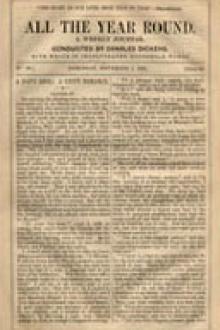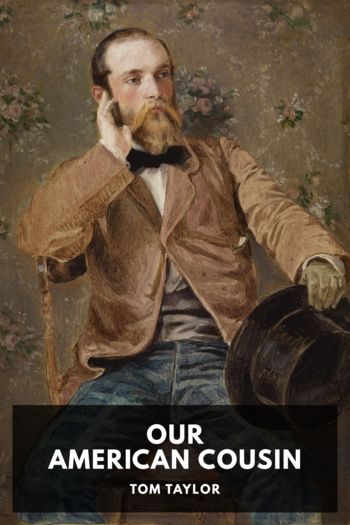Struggles and Triumphs, P. T. Barnum [good books to read in english .txt] 📗

- Author: P. T. Barnum
Book online «Struggles and Triumphs, P. T. Barnum [good books to read in english .txt] 📗». Author P. T. Barnum
Mr. N. P. Willis, then editor of the Home Journal, wrote an article illustrating the perfect good nature with which the American public submit to a clever humbug. He said that he went to Hoboken to witness the Buffalo Hunt. It was nearly four o’clock when the boat left the foot of Barclay Street, and it was so densely crowded that many persons were obliged to stand on the railings and hold on to the awning posts. When they reached the Hoboken side a boat equally crowded was coming out of the slip. The passengers just arriving cried out to those who were coming away, “Is the Buffalo Hunt over?” To which came the reply, “Yes, and it was the biggest humbug you ever heard of!” Willis added that passengers on the boat with him instantly gave three cheers for the author of the humbug, whoever he might be.
After the public had enjoyed a laugh for several days over the Hoboken “Free Grand Buffalo Hunt,” I permitted it to be announced that the proprietor of the American Museum was responsible for the joke, thus using the buffalo hunt as a skyrocket to attract public attention to my Museum. The object was accomplished and although some people cried out “humbug,” I had added to the notoriety which I so much wanted and I was satisfied. As for the cry of “humbug,” it never harmed me, and I was in the position of the actor who had much rather be roundly abused than not to be noticed at all. I ought to add, that the forty-eight thousand sixpences—the usual fare—received for ferry fares, less what I paid for the charter of the boats on that one day, more than remunerated me for the cost of the buffaloes and the expenses of the “hunt,” and the enormous gratuitous advertising of the Museum must also be placed to my credit.
With the same object—that is, advertising my Museum—I purchased, for $500, in Cincinnati, Ohio, a “Woolly Horse” I found on exhibition in that city. It was a well formed, small sized horse, with no mane, and not a particle of hair on his tail, while his entire body and legs were covered with thick, fine hair or wool, which curled tight to his skin. This horse was foaled in Indiana, and was a remarkable freak of nature, and certainly a very curious looking animal.
I had not the remotest idea, when I bought this horse, what I should do with him; but when the news came that Colonel John C. Fremont (who was supposed to have been lost in the snows of the Rocky Mountains) was in safety, the “Woolly Horse” was exhibited in New York, and was widely advertised as a most remarkable animal that had been captured by the great explorer’s party in the passes of the Rocky Mountains. The exhibition met with only moderate success in New York, and in several Northern provincial towns, and the show would have fallen flat in Washington, had it not been for the over-zeal of Colonel Thomas H. Benton, then a United States Senator from Missouri. He went to the show, and then caused the arrest of my agent for obtaining twenty-five cents from him under “false pretences.” No mention had been made of this curious animal in any letter he had received from his son-in-law, Colonel John C. Fremont, and therefore the Woolly Horse had not been captured by any of Fremont’s party. The reasoning was hardly as sound as were most of the arguments of “Old Bullion,” and the case was dismissed. After a few days of merriment, public curiosity no longer turned in that direction, and the old horse was permitted to retire to private life. My object in the exhibition, however, was fully attained. When it was generally known that the proprietor of the American Museum was also the owner of the famous “Woolly Horse,” it caused yet more talk about me and my establishment, and visitors began to say that they would give more to see the proprietor of the Museum than to view the entire collection of curiosities. As for my ruse in advertising the “Woolly Horse” as having been captured by Fremont’s exploring party, of course the announcement neither added to nor took from the interest of the exhibition; but it arrested public attention, and it was the only feature of the show that I now care to forget.
It will be seen that very much of the success which attended my many years proprietorship of the American Museum was due to advertising, and especially to my odd methods of advertising. Always claiming that I had curiosities worth showing and worth seeing, and exhibited “dog cheap” at “twenty-five cents admission, children half price”—I studied ways to arrest public attention; to startle, to make people talk and wonder; in short, to let the world know that I had a Museum.
About this time, I engaged a band of Indians from Iowa. They had never seen a railroad or steamboat until they saw them on the route from Iowa to New York. Of course they were wild and had but faint ideas of civilization. The party comprised large and noble specimens of the untutored savage, as well as several very beautiful squaws, with two or three interesting “papooses.” They lived and lodged in a large room on the top floor of the Museum, and cooked their own victuals in their own way. They gave their war-dances on the stage in the Lecture Room with great vigor and enthusiasm, much to the satisfaction of the audiences. But these wild Indians seemed to consider their dances as realities. Hence when they gave a real War Dance, it was dangerous for any parties, except their manager





Comments (0)